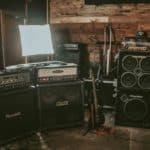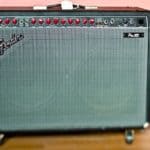When you’re trying to make music the last thing you want is to damage your equipment or your ears. Someone unplugging an instrument while it is connected to a running amp is the bane of many musicians.
But sometimes you want to change instruments and for whatever reason, you just pull the plug out of your guitar. How bad is it?
It’s unlikely to damage an amplifier by unplugging a guitar while it is on. But older speakers and tweeters can be fragile so it’s best to be careful with them. There are plenty of ways to prevent this problem, like switching the amp to standby mode before doing it.
There are some variables in equipment and different ways to avoid the auditory assault caused by a live instrument cable.
Let’s check them out because if it happens at home it’s not going to be the end of the world, but if you do it through a sound system at a live show no one is going to be thrilled with you.
Can unplugging a guitar while the amp is still on damage the amp?
I don’t think an amp is going to be damaged by the tip of the instrument cable’s plug touching something while the amplifier is on and the cable is ungrounded.
But I don’t think it’s necessarily good for the amp either.
I think damage to the speakers is more likely than damage to the amp from the harsh popping frequencies or hum that sometimes occur.
And I wouldn’t leave an amp turned on with the cable unplugged from an instrument and leave the room for a long period of time just in case.
As an extreme example of something that could happen, if you use effects pedals and have 9-volt batteries laying around your practice area, I would keep the tip of your instrument cable far, far away from the battery terminals.
I’m not about to do any science experiments with my own equipment but that is one example I can think of that would probably do some damage.
Does this work for all kinds of amps?
I think you are going to be in the clear with modern amplifiers but I would definitely be more careful with vintage amplifiers and especially combos with older speakers.
I have read comments that older shallow styles of speakers can have the coils misaligned by “shocks”.
Furthermore, I know that the material of speaker cones and especially larger speakers with surrounds (the foam-like ring connecting the cone and frame on some speakers) deteriorates over time so they may be more susceptible to misuse.
And if you are using a speaker configuration with tweeters or piezo speakers, they tend not to take much abuse, so care is advised when unplugging your instrument with these as well.
Just how fragile are tube amps?
If you mainly use solid-state amps then there is no problem with just switching the amp off before unplugging your instrument.
But tube amps can be more finicky because the tubes need to heat up and most people feel that tubes don’t like to be turned on and shut off in rapid succession because they are heating up and cooling off every time.
But that is a whole different discussion. If you want some more tips on how to care for a tube amp you can check out our article about it here:
Let’s get back to business and check out some of the options available if you need to keep switching guitars.
Is it okay to just switch the amp to standby for unplugging a guitar?
If you are using a tube amp then one of the simplest ways to prevent this problem is probably already on the front of your amp.
So go ahead and use the standby switch if you have one. What do you think it’s there for, decoration?
Should you always turn off your amp before plugging or unplugging a guitar?
If you don’t have a standby switch there are plenty of other ways to help you switch instruments peacefully and quietly.
For solid-state, you can certainly turn off your amp to unplug but if you are using a tube amp and aren’t comfortable powering it down frequently, you should try these workarounds.
The easiest thing you can do is to unplug the cable from the amplifier jack first. You don’t even have to take it out all the way: just enough to switch the jack off and this method won’t cost you anything.
Another easy fix is simply to turn down the volume of your amp before unplugging your guitar. This is what I usually do if the amp is close to me.
But what if your amp isn’t right next to you?
If you’re ready to spend a little money you can add an interrupt in your signal chain.
One way to do this is with an A/B switcher pedal that can be purchased for under $40.
Simply connect your amp to the A output and leave the B output empty.
That way when you want to unplug your guitar you can simply break the connection to your amp by switching to the empty B output.
You could also achieve much the same result with a volume pedal by lowering it all the way instead of turning down the volume on the amp.
Then there are a few types of specialty silent plugs available for instrument cables.
Planet Waves offers a silent plug that uses a switch to turn off the tip of the plug. I haven’t personally used this plug but it seems like a decent option.
I have tried the silent plugs available from Neutrik before with mixed results.
They use a spring mechanism to ground the plug when it isn’t plugged into anything.
But although Neutrik and Switchcraft are the best quality plugs available in my opinion, I have seen the Neutrik silent plugs go bad before, because you’re adding moving parts to something that normally doesn’t have any and there isn’t much room, meaning the metal spring inside is very small and can break.
You can try out any of these and see what works best for you.
Personally, I just prefer to turn the amp volume down and if it wasn’t convenient I would probably go for the A/B switcher pedal option.
Whatever you choose to do, just do something. Although I don’t think you are likely to damage your amplifier by unplugging your instrument it sure is annoying and unprofessional.

Hello there, my name is Ramiro and I’ve been playing guitar for almost 20 years. I’m obsessed with everything gear-related and I thought it might be worth sharing it. From guitars, pedals, amps, and synths to studio gear and production tips, I hope you find what I post here useful, and I’ll try my best to keep it entertaining also.





